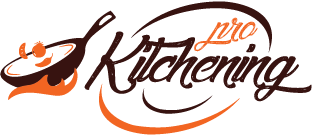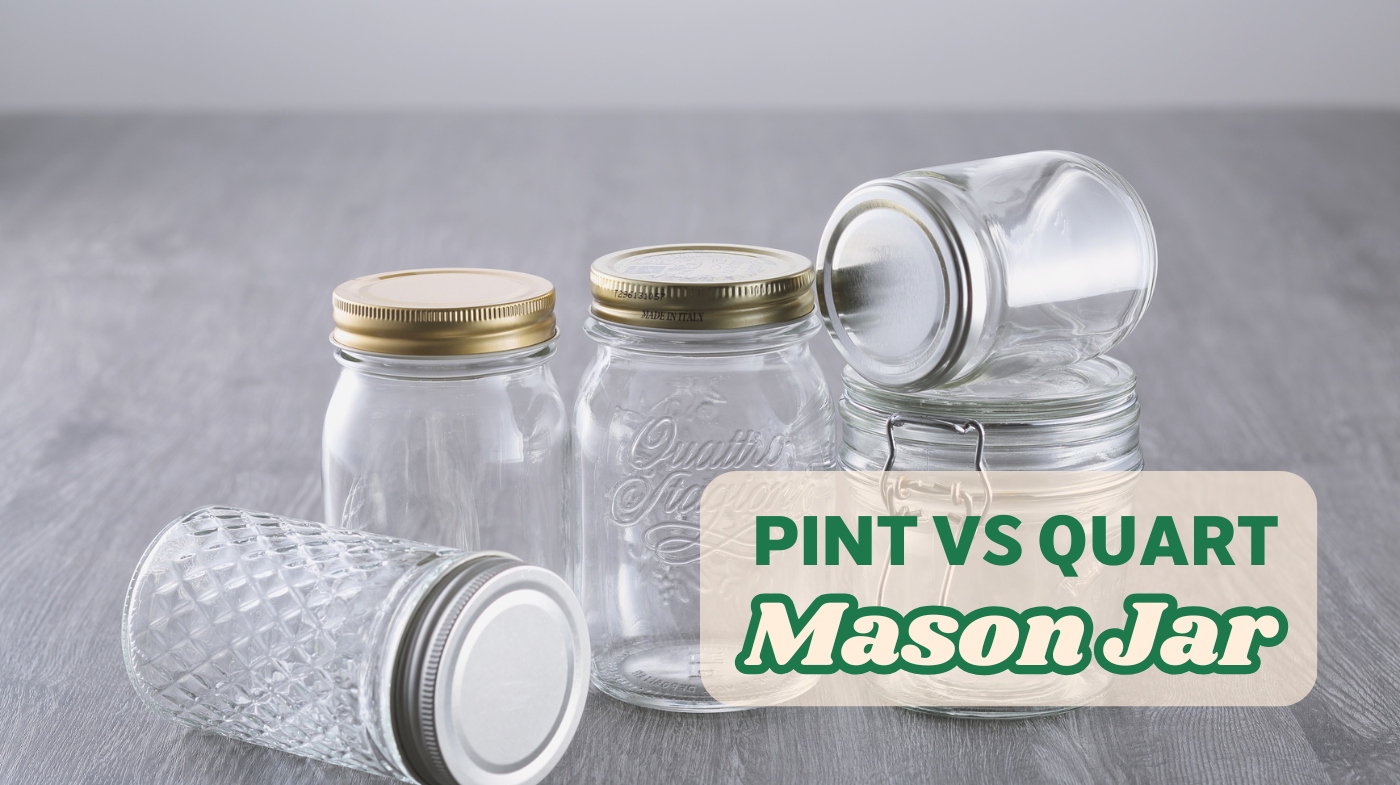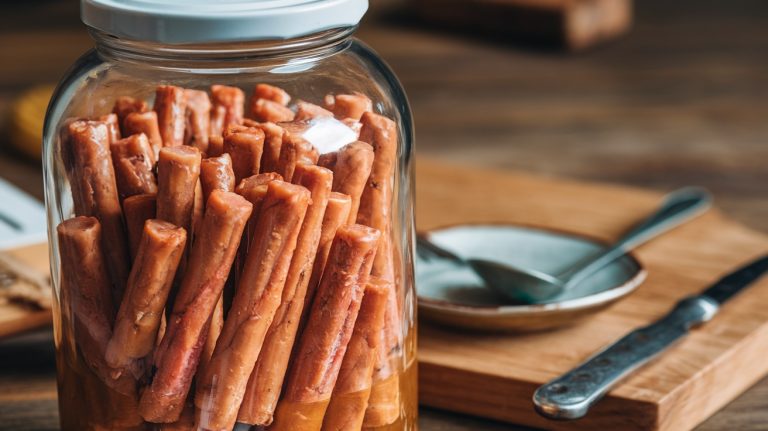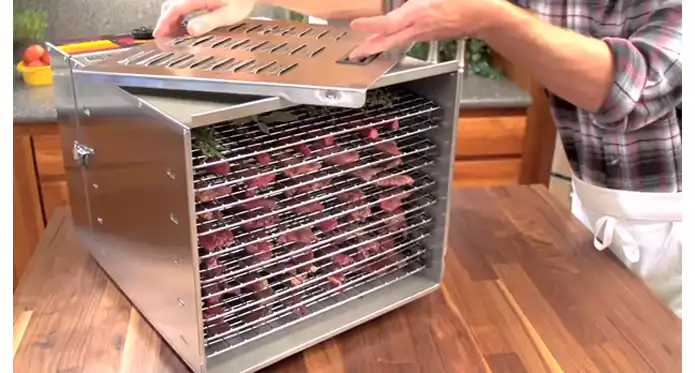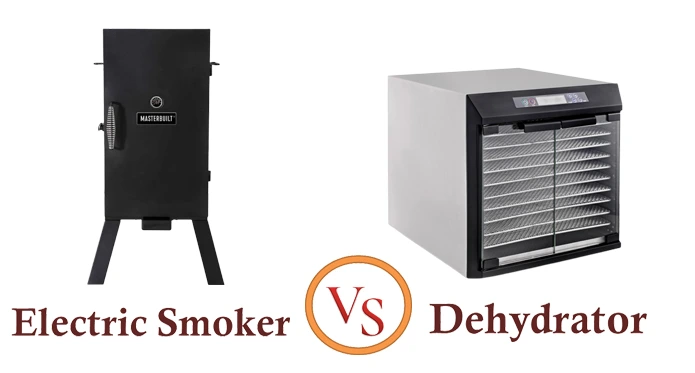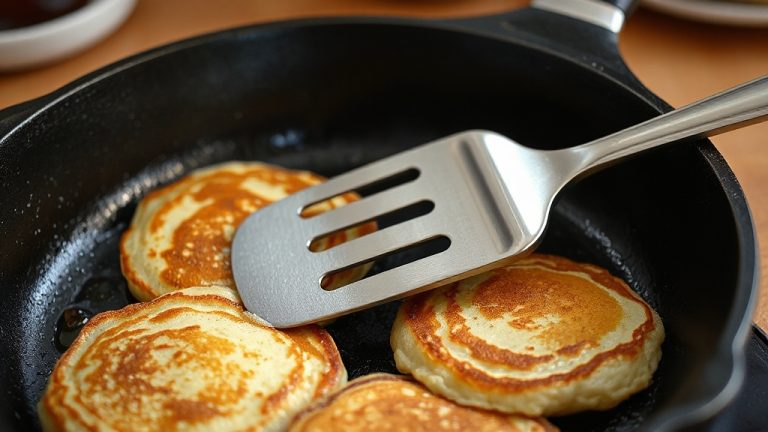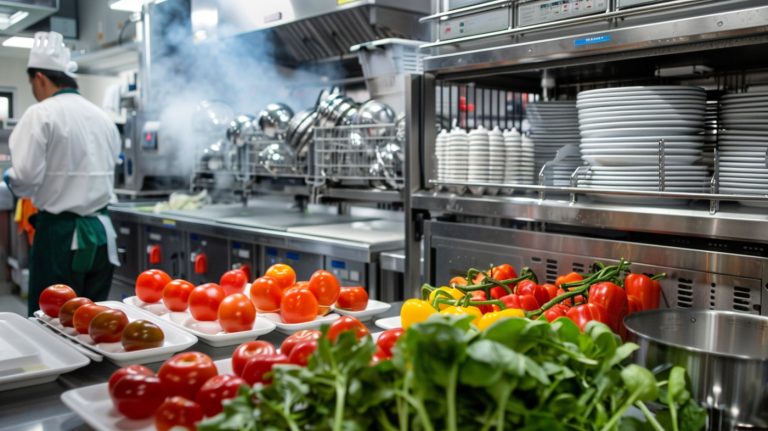Pint vs Quart Mason Jar: Which One is Right for You?
Pint and quart mason jars serve different purposes in food storage. Pint jars hold 16 ounces, making them perfect for small batches of jams or snacks. Quart jars, on the other hand, hold 32 ounces, ideal for larger meals like soups and broths.
Each has distinct fill lines to prevent spills during processing, ensuring safe preservation. Choosing the right jar can impact your canning success greatly. Discover more about selecting the perfect jar for your needs.
Key Takeaways
- Pint jars hold 16 ounces, while quart jars hold 32 ounces, making quart jars double the capacity of pint jars.
- Pint jars are ideal for canning small batches like jams and jellies, whereas quart jars suit larger quantities like soups and broths.
- Processing times differ; quart jars require longer processing than pint jars due to their larger volume.
- Proper fill lines are essential; pint jars require 1/8 inch headspace for jams, while quart jars need to be filled to the freeze-fill line.
- Consider your storage space and intended use when selecting between pint and quart jars for efficiency and organization.
Understanding Jar Volume and Capacity
When you’re diving into the world of canning, understanding jar volume and capacity is essential for successful preservation. Pint jars hold 16 ounces, or 2 cups, while quart jars double that with 32 ounces, or 4 cups.
Both come in regular and wide mouth styles, affecting how you fill and empty them. Regular mouth jars, with smaller openings, are perfect for pourable items, while wide mouth jars accommodate larger contents like whole vegetables.
Their dimensions also matter; pint jars are about 5 inches tall, and quart jars reach around 6.75 inches. This height difference influences stacking efficiency in canners, so knowing these specifications helps you optimize your canning experience and choose the right jar for your culinary projects.
Additionally, specific jars have designated uses that can further guide your selection based on your intended application. Choosing the right jar size is crucial for successful canning practices and effective food preservation.
Common Uses for Pint and Quart Jars
When you think about pint and quart mason jars, you’ll find they’re incredibly versatile for various tasks. From canning your favorite preserves to organizing pantry staples, these jars serve multiple purposes in your kitchen and beyond.
Plus, they can add a charming touch to your home decor, making them a must-have in any household. Additionally, they are perfect for packing away leftovers, ensuring your meals remain fresh and organized.
You can also use them for layering ingredients to create easy-to-make soup in a jar, providing a quick meal option for busy days.
Canning Food Varieties
Whether you’re a seasoned canner or just starting out, understanding the common uses for pint and quart Mason jars can enhance your food preservation experience.
Pint jars shine when you’re making jams, jellies, and pickles, offering the perfect size for small batches of sauces and chutneys. They’re also great for fruit preserves like strawberry jam.
On the other hand, quart jars excel with larger quantities, ideal for canning broths, soups, and bulk sauces. They accommodate mixed vegetables and are perfect for pressure canning meats and poultry.
Storage Solutions
Mason jars, with their timeless charm and practicality, offer a myriad of storage solutions for your kitchen and pantry. You can use pint jars for snacks, while quart jars are perfect for meal prep salads and bulk storage.
Their airtight seals keep food fresh and organized. Additionally, using a variety of jar sizes can enhance your collection practices, allowing for better organization and separation of different food items.
| Use | Pint Jar | Quart Jar |
|---|---|---|
| Leftover Storage | Ideal for small meals | Great for larger portions |
| Snack Packs | Perfect for portioning | Holds bulk snacks |
| Pantry Organization | Suitable for small goods | Best for bulk items |
| Baking Supplies | Stores smaller items | Holds flour, sugar |
| Meal Prep Salads | Not ideal | Excellent choice |
These jars provide versatility and efficiency, making them essential for every kitchen.
Home Decor Ideas
Pint and quart mason jars aren’t just for food storage; they can also elevate your home decor with their rustic charm and versatility. Use them as vases to showcase fresh flowers, bringing a touch of nature indoors.
Transform jars into candle holders for a warm ambiance, or fill them with fairy lights and photos for a personalized display. You can create whimsical centerpieces with floating flowers or seasonal decor, while wrapping jars in lace or twine adds texture.
These jars are perfect for showcasing collections, crafting unique gifts, or even creating mood lighting with glowing elements, making them ideal for creative floral arrangements. Whether it’s for everyday use or special occasions, mason jars offer endless creative possibilities for your home.
Key Differences Between Pint and Quart Jars
When you’re choosing between pint and quart jars, understanding their volume differences is key. Pint jars hold 16 ounces, perfect for smaller canning projects like jams, while quart jars double that capacity at 32 ounces, making them ideal for larger batches like soups or whole fruits.
Knowing how much each jar can hold helps you decide which is best for your canning needs. Additionally, selecting the right jar size ensures proper food preservation and maintains the flavor and quality of your canned goods.
Volume Comparison
Choosing between pint and quart jars often comes down to understanding their volume differences. Pint jars hold 16 ounces, equating to 2 cups, while quart jars can hold 32 ounces, or 4 cups.
Fundamentally, a quart jar is double the volume of a pint jar, making it vital to select the right size for your needs. When considering canning, it’s essential to note that different pressure canner jar capacities can influence your choice of jar size.
This difference matters when you’re storing anything from jams to soups, ensuring you’ve got the right capacity for your ingredients.
Usage in Canning
Understanding the differences between pint and quart jars is essential for successful canning. Pint jars are perfect for smaller batches of jams, jellies, and sauces, making them ideal for smaller families or quick projects.
If you’re canning whole fruits or vegetables, consider using wide-mouth quart jars for their larger capacity. Processing times vary based on jar size, so always refer to tested recipes to guarantee safety. For soups and stews, quart jars shine due to their volume.
Different jar shapes serve various purposes in canning, allowing for creativity in your culinary endeavors. Whether you choose pint or quart, each jar type has its role, pints offer flexibility while quarts cater to larger needs.
Ideal Foods for Canning in Pint vs. Quart Jars
Whether you’re looking to preserve the flavors of summer or prepare hearty meals for the winter, knowing which foods to can in pint versus quart jars can make a significant difference.
- Pint jars are perfect for individual servings of creamy soups or small-batch jams. Additionally, canned meals can be conveniently stored in pint jars for easy meal prep.
- Quart jars shine when you’re canning a big pot of chili or a family-sized stew.
- When pickling vegetables, pint jars keep your creations fresh and manageable, while quart jars allow for bulk storage of flavorsome sauces.
Fill Lines and Their Importance
When canning, understanding fill lines is essential to your success. Proper filling techniques not only help achieve a tight seal but also prevent spoilage and guarantee your food maintains its flavor and texture.
Using regular and wide mouth jars appropriately for different food types can further enhance the canning process.
Fill Line Significance
Fill lines on Mason jars play an important role in guaranteeing safe and effective storage for your canned goods. These guides help you avoid overfilling, which can lead to jar breakage or spills.
When freezing, leaving space for expansion is essential, and fill lines provide that guidance. Using the correct jar size is crucial for safe canning practices, as it ensures that you maintain appropriate headspace.
- Confidence in your canning process: You’ll know exactly how much to fill, reducing anxiety about potential mishaps.
- Cleaner storage: Preventing spills keeps your storage area tidy and organized.
- Food safety assurance: Following fill line guidelines helps preserve food quality and guarantees safety.
Whether you’re using pint or quart jars, respecting these fill lines is critical to keeping your delicious homemade goods secure and fresh.
Proper Filling Techniques
Understanding proper filling techniques is essential for ensuring the quality and safety of your canned goods.
For pint jars, fill to the bottom of the neck when using hot syrup, leaving about 1/8 inch of headspace for jellies and jams. This small gap is vital to accommodate any expansion without compromising the seal.
Quart jars, on the other hand, require you to fill to the freeze-fill line to prevent cracking during freezing. Always remember that standard fill lines are typically marked about an inch below the rim, ensuring you leave enough space for any liquid to expand safely.
Additionally, it’s crucial to fill jars to the freeze-fill line to avoid breakage when freezing liquids.
Avoiding Overfilling Risks
To prevent the risks associated with overfilling, it’s crucial to pay attention to the designated fill lines on your Mason jars. Ignoring these guidelines can lead to frustrating mishaps, such as broken jars and wasted food.
- Cracks and spills can ruin your carefully prepared meals.
- The stress of cleaning up shattered glass is a headache no one wants.
- Watching your hard work go to waste feels disheartening.
For both pint and quart jars, leave about 1 to 2 inches of headspace. This space allows liquids to expand during freezing without cracking the glass.
Additionally, using straight sided jars helps reduce the risk of breakage during the freezing process. Always check for freeze lines or use general guidelines, ensuring your frozen treasures stay intact and ready to enjoy.
Size Variations and Their Impact on Use
When choosing between pint and quart Mason jars, the size variations greatly influence how you can use them in your kitchen and beyond.
Pint jars, holding 16 oz, are perfect for smaller batches, whether you’re making jams or storing snacks. Their compact size makes them easy to stack in canners or cupboards. Additionally, canning jars seal in freshness and taste, ensuring the quality of your preserved foods.
On the other hand, quart jars, with a capacity of 32 oz, are ideal for preserving larger quantities, perfect for family meals or bulk storage. Their taller design offers more vertical space, accommodating larger items.
Additionally, wide mouth options simplify filling and cleaning, while regular mouth jars minimize spills. The choice between sizes ultimately depends on your specific needs and how you plan to organize your food storage.
Processing Times for Canning
Choosing the right size Mason jar not only affects storage but also plays a significant role in canning success, particularly regarding processing times. Quart jars take longer to process than pint jars, which can be essential when you’re managing a busy kitchen.
Keep in mind that factors like elevation and pack style also influence your canning experience.
- Higher elevations mean longer processing times.
- Hot-packed foods require less time than raw-packed.
- Each food type has its unique processing requirements. Additionally, acid foods need to be processed for the correct number of minutes in boiling water to ensure safety.
Choosing Between Regular and Wide Mouth Jars
While selecting the right Mason jar style may seem trivial, it can greatly influence your canning experience. Regular mouth jars, with their narrower openings, excel at pouring pourable foods like jams and jellies, minimizing spills.
On the other hand, wide mouth jars make filling and emptying a breeze, perfect for whole fruits and vegetables. Both styles come in various sizes, including pint and quart, allowing you to choose what fits your needs best.
You’ll also find that both types share consistent lid sizes, making it easy to switch between brands like Ball and Kerr. Additionally, wide mouth design facilitates easy filling and cleaning, making them ideal for meal prep.
Storage and Freezing Tips for Mason Jars
After you’ve picked the right Mason jar style for your canning needs, it’s time to think about how to store them properly and the best ways to handle freezing.
To prevent breakage, keep your jars in low spaces, and consider creating a custom DIY canning cupboard for both organization and style. Proper storage helps keep jars in mint condition for future use.
Once you’ve chosen the perfect Mason jar, focus on safe storage and organization to enhance your kitchen’s charm.
If you need extra storage, high cabinets work well but don’t forget that Mason jars shouldn’t be frozen due to breakage risks.
- Create a cozy kitchen atmosphere by displaying jars on open shelves.
- Use original boxes to keep your jars organized and safe.
- Turn your jars into beautiful decor with flowers or herbs.
Frequently Asked Questions
Can I Use Pint Jars for Freezing Food?
Absolutely, you can use pint jars for freezing food! Their size is perfect for small to medium portions, making them space-efficient in your freezer. Just remember to leave about an inch of headspace for expansion and cool your food before storing.
They’re great for liquids, purees, and individual meals. Plus, they’re reusable and non-toxic, so you’re making a smart choice for both your wallet and the environment!
Are Quart Jars Heavier Than Pint Jars?
Yes, quart jars are heavier than pint jars. The larger volume and increased glass content contribute to this weight difference. When you handle them, you’ll notice that quart jars require a bit more effort to lift and store.
If you’re planning to use them for canning or storage, keep in mind their heft, especially if you’re working with multiple jars. It’s always good to reflect on how weight impacts your projects and storage solutions!
How Many Pint Jars Fit in a Quart Jar?
When you think about volume, imagine two pint jars side by side, each holding 16 ounces. Now picture a quart jar, standing tall at 32 ounces, ready to embrace those pints. You’ll find that two pint jars fit perfectly within a quart jar, doubling up on delightful preserves or sauces.
It’s a simple yet effective way to understand capacity, making your canning adventures more organized and efficient as you create delicious treats.
Can I Mix Jar Sizes When Canning?
Yes, you can mix jar sizes when canning, but it’s essential to process all jars according to the largest size’s recommended time.
This guarantees that everything reaches a safe temperature. Make certain the jars are compatible with the same processing method and that they’re suitable for canning.
What Materials Are Mason Jars Made Of?
Did you know that Mason jars are primarily made of soda lime glass, which accounts for about 90% of glass containers produced worldwide?
When you use Mason jars, you’re enjoying a product crafted from sand, soda ash, and limestone, all heated to extreme temperatures. Their lids, made of tin, and silicone gaskets complete the design.
This combination guarantees your food stays safe and fresh while being environmentally friendly when recycled properly.
Choosing the Best Mason Jar for Your Food Storage Needs
In the end, choosing between pint and quart Mason jars isn’t just about size; it’s about what you want to create and preserve. Imagine the vibrant colors of your home-canned tomatoes or pickles, neatly lined up on the shelf.
Will you opt for those charming pint jars, perfect for small batches, or the substantial quart jars, ideal for larger quantities? The decision holds the key to your culinary adventures. So, what will you choose to fill your jars with next?
